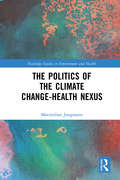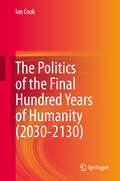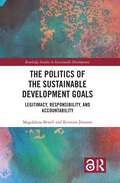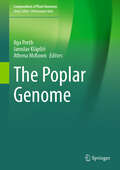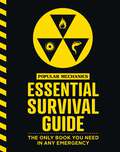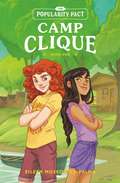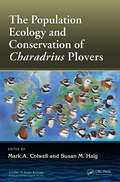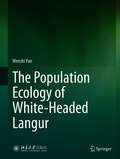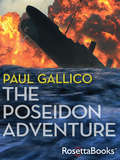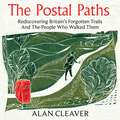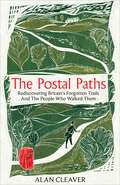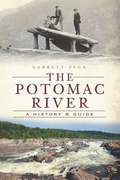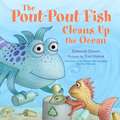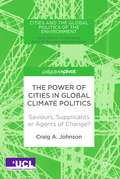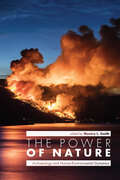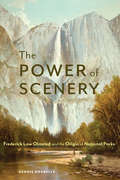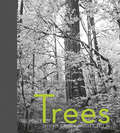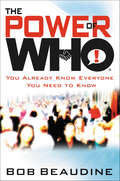- Table View
- List View
The Politics of the Climate Change-Health Nexus (Routledge Studies in Environment and Health)
by Maximilian JungmannThis book compares how governments in 192 countries perceive climate change related health risks and which measures they undertake to protect their populations. Building on case studies from the United Kingdom, Ireland, South Korea, Japan and Sri Lanka, The Politics of the Climate Change-Health Nexus demonstrates the strong influence of epistemic communities and international organisations on decision making in the field of climate change and health. Jungmann shows that due to the complexity and uncertainty of climate change related health risks, governments depend on the expertise of universities, think tanks, international organisations and researchers within the public sector to understand, strategize and implement effective health adaptation measures. Due to their general openness towards new ideas and academic freedom, the book shows that more democratic states tend to demonstrate a higher recognition of the need to protect their populations. However, the level of success largely depends on the strength of their epistemic communities and the involvement of international organisations. This volume will be of great interest to students and scholars of climate change and public health. It will also be a valuable resource for policymakers from around the world to learn from best practices and thus improve the health adaptation work in their own countries.
The Politics of the Environment
by Neil CarterThe continuous rise in the profile of the environment in politics reflects growing concern that we may be facing a large-scale ecological crisis. The new edition of this highly acclaimed textbook surveys the politics of the environment, providing a comprehensive and comparative introduction to its three components: ideas, activism and policy. Part I explores environmental philosophy and green political thought; Part II considers parties and environmental movements; and Part III analyses policy-making and environmental issues at international, national and local levels. This second edition has been thoroughly updated with new and revised discussions of many topics including the ecological state, ecological citizenship, ecological modernisation and the Greens in government and also includes an additional chapter on 'Globalisation, trade and the environment'. As well as considering a wide variety of examples from around the world, this textbook features a glossary, guides to further study, chapter summaries and critical questions throughout. Book jacket.
The Politics of the Final Hundred Years of Humanity (2030-2130)
by Ian CookThis book is the first book that looks at both the politics of maintaining the trajectory toward humanity’s final hundred years and the politics of those final hundred years. It is the first book to take up theoretical and practical aspects with respect to both the movement toward and events during these final hundred years. As a result, it is the first book that attempts to provide a more complete picture of the politics of catastrophic human-caused environment change.The fact that the book provides a way into the variety of policy problems that catastrophic human-caused environment change is creating means that it is also important to those in Public Policy. The book also raises a series of philosophical and ethical questions associated with human rights, which are significant to those who study Political Philosophy (and some of those who study Law), international action to mitigate the effects of climate change, the nature of science and the limitations of political institutions.
The Politics of the Sustainable Development Goals: Legitimacy, Responsibility, and Accountability (Routledge Studies in Sustainable Development)
by Magdalena Bexell Kristina JönssonThis book draws attention to political aspects of sustainable development goal-setting, exploring the Sustainable Development Goals (SDGs) at the global-national nexus during their first five years. After broad global deliberation and political negotiations, the 2030 Agenda and its SDGs were adopted in the United Nations (UN) General Assembly in 2015, and by now many countries have political structures in place for working towards their realisation. This book explores three concepts to call attention to the political qualities of processes related to the SDGs: legitimacy, responsibility, and accountability. Legitimacy is required to obtain broad political ownership for policy goals in order for them to become effective in addressing cross-border sustainability challenges. Responsibility needs to be clearly distributed among political institutions if a long-term set of broad goals such as the SDGs are to be realised. Accountability to the public is the retrospective mirror of political responsibility. The Politics of the Sustainable Development Goals contributes new knowledge on political processes at the nexus of global and national levels, focussing on three countries at different levels of socio-economic development and democratisation: namely Ghana, Tanzania, and Sweden. These countries illustrate a variety of challenges related to the realisation of the SDGs. This book will be of great interest to students and scholars of sustainable development, international organisations, and global politics.
The Poplar Genome (Compendium of Plant Genomes)
by Ilga Porth Jaroslav Klápště Athena McKownThis book is the first comprehensive compilation of research on state‐of‐the-art genomics on the most advanced model tree species including genome assemblies, insights into genomic structural features and methylation patterns, whole‐genome resources used for population genomics and adaptation to climate, enabled breeding vs. classical genetics and traditional breeding, comparative genomics, and elucidations on functional genomics. The latest developments in the genomics of wood formation are particularly highlighted. Altogether, the book contains over 300 pages in over 15 chapters authored by globally reputed experts in the relevant fields of this tree crop’s genomics research. This book is useful for students, teachers, and scientists in academia and governmental or private tree improvement agencies or companies interested in genetics, pathology, entomology, physiology, molecular genetics and breeding, in vitro culture and genetic engineering, land restoration, and agroforestry solutions.
The Popular Mechanics Essential Survival Guide: The Only Book You Need in Any Emergency
by Popular MechanicsPopular Mechanics' ultimate survival manual will teach you the essential skills to protect your family, save yourself, and conquer any possible danger. In an emergency, would you know how to survive—to purify water, jump-start a car, escape a flood or fire, forage for firewood, protect your family? Whether the threat is low or the risk is apocalyptic, Popular Mechanics can help you handle it with lifesaving advice for dangerous situations. Crucial information on how to handle the critical decisions you might face both immediately and in the long term will help you not only survive, but thrive in the aftermath of any disaster. Also includes expert tips on must-have equipment to keep on hand as well as many dramatic survival stories (including lessons from a dog sledder and the account of a helicopter pilot who crashed into the icy waters of the Arctic).
The Popularity Pact: Book One (The Popularity Pact #1)
by Eileen Moskowitz-PalmaIn the blink of a summer, Bea goes from having a best friend and a place she belongs to being dropped and invisible, eating lunch alone and only talking to teachers. The end of sixth grade and the start of Camp Amelia can't come soon enough. But then the worst part of school, ex-best friend Maisy, shows up in Bea's safe place and ruins it all. Maisy lands in the same bunk as Bea and summer suddenly seems dire. Never having camped a day in her life, Maisy agrees: it's hopeless. She should be at home, spending time with her little sister and hanging out with her super popular crew of friends--not at this stupid adventure camp failing everything and being hated by everyone. In a desperate bid to belong, Maisy offers Bea a deal: if Bea helps her fit in at the camp, she will get Bea into the M & M's, their town's popular clique, when they enter seventh grade in the fall. The Popularity Pact is born.
The Population Ecology and Conservation of Charadrius Plovers (Studies in Avian Biology #53)
by Mark A. Colwell Susan M. HaigThe 40 or so species of beach-loving plovers (genus Charadrius) comprise a diverse group of shorebirds found around the world. Most of these species are challenged by changing climates and other human-related development activities, yet they provide key insights into basic ecological and evolutionary processes. The expert international contributors take a comparative approach, presenting examples from many worldwide plover studies and synthesizing the group’s most pressing and important topics. The book further presents an emphasis on full life-cycle biology, including the importance of examining migratory connectivity issues, even for non-migratory plovers. Key Features Serves as a fundamental resource for conservation practitioners Detailed overview of a widely distributed group of shorebirds Authored by renowned specialists who present theoretical and applied perspectives Emphasis on comparative and synthetic approach in all chapters Related Titles McComb, B. et al. Monitoring Animal Populations and Their Habitats: A Practitioner’s Guide (ISBN 978-0-4291-3827-0). Garvey, J. E. & M. R. Whiles. Trophic Ecology (ISBN 978-1-4987-5846-8). Dewdney, A. K. Stochastic Communities: A Mathematical Theory of Biodiversity (ISBN 978-1-1381-9702-2).
The Population Ecology of White-Headed Langur
by Wenshi PanThis book offers a rare and detailed insight into 20 years’ of in-depth field research and conservation of the white-headed langur. It focuses on the white-headed langur’s natural refuge, territory and home range, diets and foraging strategies, behavior modes, reproductive strategies, population, possible future viabilities, and their interaction with human society. From 1996 through 2016, a small research team led by Prof.Wenshi Pan from Peking University conducted studies and conservation efforts on the white-headed langur, one of the most endangered endemic species of China, in Guangxi and saved the species from extinction. With the help of conservationists’ efforts, the white-headed langur population in Nongguan Mountains, Guangxi, gradually increased from 105 to approximately 820.This book shares the success story of the unification of human development and wildlife conservation.
The Poseidon Adventure
by Paul GallicoThe high-octane thriller that inspired the Academy Award–winning film: On a sinking cruise ship, passengers fight rising water—and each other—to survive. On its maiden voyage, luxury ocean liner SS Poseidon is capsized by a massive undersea earthquake. A handful of survivors must fight for their lives—struggling to make it from the upper deck of the ship to the hull, the only part above water, before the ship sinks. Faced with rising water and the violence of desperate passengers and crewmembers, the group must do everything it can to survive—before time runs out. Adapted into an award-winning film by Irwin Allen, The Poseidon Adventure is a thrilling tale with timeless suspense and excitement.
The Postal Paths: Rediscovering Britain’s Forgotten Trails And The People Who Walked Them
by Alan Cleaver'A fascinating exploration of routes trod by generations of rural postmen and women - lovingly told and lively.'-JACK CORNISH, author of The Lost Paths'A delightful exploration of one of our most important cultural figures in the community, the postman. Postal Paths journeys around the UK, unearthing forgotten stories... You will never look at a postman in the same way again.' -REBECCA SMITH, author of Rural: The Lives of the Working Class Countryside'Charming... Cleaver brings to the life the lives of those who served their communities.'-KIRAN SIDHU, author of I Can Hear The Cuckoo***Seeing the hills, the crofts, villages and ruins only tells half the story. The people who worked, walked, lived and died here are the other half.Postal paths span the length and breadth of Britain - from the furthermost corners of the Outer Hebrides to the isolated communities clinging to the cliffs of the Rame Peninsula in south-east Cornwall. For over 200 years, postmen and women have delivered post to homes across Britain on foot, no matter how remote.A chance remark by a farmer about a Postman's Path led Alan Cleaver on a quest to discover more about this network of lanes, short-cuts and footpaths in the British landscape. From the rolling fells of Cumbria to Kent's shingle coast, he walked in the footsteps of 20th Century posties. And what he found, through conversation and painstaking research, was not just beautiful scenery. It was an incredible, forgotten slice of social history - the tales and toil of rural postmen and women trudging down lanes, over fields, and even across rivers to make sure the post always came on time.From women like Hannah Knowles, who began her job delivering letters in 1912 and would only miss three days through illness over the next 62 years of service, to a WW1 veteran who completed his 9-mile delivery route on one leg, Postal Paths paints a vivid picture of people who not only served communities but brought them together, one letter at a time.
The Postal Paths: Rediscovering Britain’s Forgotten Trails And The People Who Walked Them
by Alan Cleaver'A fascinating exploration of routes trod by generations of rural postmen and women - lovingly told and lively.'-JACK CORNISH, author of The Lost Paths'A delightful exploration of one of our most important cultural figures in the community, the postman. Postal Paths journeys around the UK, unearthing forgotten stories... You will never look at a postman in the same way again.' -REBECCA SMITH, author of Rural: The Lives of the Working Class Countryside'Charming... Cleaver brings to the life the lives of those who served their communities.'-KIRAN SIDHU, author of I Can Hear The Cuckoo***Seeing the hills, the crofts, villages and ruins only tells half the story. The people who worked, walked, lived and died here are the other half.Postal paths span the length and breadth of Britain - from the furthermost corners of the Outer Hebrides to the isolated communities clinging to the cliffs of the Rame Peninsula in south-east Cornwall. For over 200 years, postmen and women have delivered post to homes across Britain on foot, no matter how remote.A chance remark by a farmer about a Postman's Path led Alan Cleaver on a quest to discover more about this network of lanes, short-cuts and footpaths in the British landscape. From the rolling fells of Cumbria to Kent's shingle coast, he walked in the footsteps of 20th Century posties. And what he found, through conversation and painstaking research, was not just beautiful scenery. It was an incredible, forgotten slice of social history - the tales and toil of rural postmen and women trudging down lanes, over fields, and even across rivers to make sure the post always came on time.From women like Hannah Knowles, who began her job delivering letters in 1912 and would only miss three days through illness over the next 62 years of service, to a WW1 veteran who completed his 9-mile delivery route on one leg, Postal Paths paints a vivid picture of people who not only served communities but brought them together, one letter at a time.
The Potomac River: A History & Guide (History And Guide Ser.)
by Garrett PeckThe story of the Potomac is the story of America—take a historic hike with this fascinating guide. The great Potomac River begins in the Alleghenies and flows 383 miles through some of America's most historic lands before emptying into the Chesapeake Bay. The course of the river drove the development of the region and the path of a young republic. Maryland's first Catholic settlers came to its banks in 1634 and George Washington helped settle the new capital on its shores. During the Civil War the river divided North and South, and it witnessed John Brown's raid on Harper's Ferry and the bloody Battle of Antietam. In this book, Garrett Peck leads readers on a journey down the Potomac, from its first fount at Fairfax Stone in West Virginia to its mouth at Point Lookout in Maryland. Combining history with recreation, Peck has written an indispensible guide to the nation's river.
The Pout-Pout Fish Cleans Up the Ocean (A Pout-Pout Fish Adventure #4)
by Deborah DiesenThis addition in the New York Times–bestselling Pout-Pout Fish series from Deborah Diesen and illustrator Dan Hanna, The Pout-Pout Fish Cleans Up the Ocean, will teach little guppies how to take responsibility for their actions and for the environment. Mr. Fish and his friends have noticed something strange in their ocean—a big, big MESS! How did it get there? What can they do about it? The closer they look, the more they see where the mess came from . . . and they'll have to work together to get rid of it.
The Power of Cities in Global Climate Politics
by Craig A. JohnsonThere is now a palpable sense of optimism about the role of cities and transnational city-networks in global climate governance. Yet, amidst the euphoria, there is also a sense that the power that has been ascribed to – and frequently assumed by – cities has been overstated; that the power of cities and city-networks to make a difference in global climate politics is not what it appears. This book explores the implications of city-engagement in global climate politics, outlining a theoretical framework that can be used to understand the power of cities in relation to transnational city-networks, multinational corporations and nation-states. The book will be of interest to students and scholars of transnational governance, global environmental politics and climate change.
The Power of Energy Justice & the Social Contract (Just Transitions)
by Raphael J. Heffron Louis De FontenelleThis open access book focuses on the energy sector and will make a significant contribution to its continued evolution. For many years, the energy sector has been missing a raison d’etre and now finally there are increased calls for that to be justice. Hence, this book will develop the concept of energy justice and how it needs to be formalised in a new ‘social contract’ with all stakeholders in society. The focus will be on improving legal systems at local, national and international levels while ensuring that justice is a core issue within energy law, the legal system and more broadly in society.
The Power of Nature: Archaeology and Human-Environmental Dynamics
by Monica L. SmithIn The Power of Nature archaeologists address the force and impact of nature relative to human knowledge, action, and volition. Case studies from around the world focusing on different levels of sociopolitical complexity—ranging from early agricultural societies to states and empires—address the ways in which nature retains the upper hand in human agentive environmental discourse, providing an opportunity for an insightful perspective on the current anthropological emphasis on how humans affect the environment. Climatic events, pathogens, and animals as nonhuman agents, ranging in size from viruses to mega-storms, have presented our species with dynamic conditions that overwhelm human capacities. In some cases, people have modified architecture to deal with a constant onslaught of storms, as in Japan or the Caribbean; in other cases, they have welcomed the occasional natural disaster as a chance to start fresh or to put into place new ideas and practices, as in the case of ancient Roman cities. Using the concept of “agency” as one in which multiple sentient and nonhuman actors interact in a landscape, and exploring locations such as the Caribbean, the Pacific, South Asia, the Andes, the Mediterranean, Mesoamerica, North America, and the Arctic, the authors provide compelling explanations of the effect of an entire realm of natural powers that beset human societies past and present—from storms, earthquakes, and fires to vegetation, domestic animals, and wild birds. Throughout, the emphasis is on the philosophical and engineering adjustments that people make to stay resilient when facing the perpetual changes of the natural world. Using an archaeological perspective, The Power of Nature illustrates and analyzes the many ways that people do not control their environments. It will be of interest to archaeologists, as well as scholars in science, biology, botany, forestry, urban studies, and disaster management. Contributors: Steven Ammeran, Traci Ardren, Katelyn J. Bishop, Karen Mohr Chávez, Sergio Chávez, Stanislava Chávez, Emelie Cobb, Jago Cooper, Harper Dine, Chelsea Fisher, Jennifer Huebert, Dale L. Hutchinson, Sara L. Juengst, Kanika Kalra, François Oliva, Matthew C. Peros, Jordan Pickett, Seth Quintus, John Robb, Monica L. Smith, Jillian A. Swift, Silvia Tomášková, Kyungsoo Yoo
The Power of Nature: Archaeology and Human-Environmental Dynamics
by Monica L. SmithIn The Power of Nature archaeologists address the force and impact of nature relative to human knowledge, action, and volition. Case studies from around the world focusing on different levels of sociopolitical complexity—ranging from early agricultural societies to states and empires—address the ways in which nature retains the upper hand in human agentive environmental discourse, providing an opportunity for an insightful perspective on the current anthropological emphasis on how humans affect the environment. Climatic events, pathogens, and animals as nonhuman agents, ranging in size from viruses to mega-storms, have presented our species with dynamic conditions that overwhelm human capacities. In some cases, people have modified architecture to deal with a constant onslaught of storms, as in Japan or the Caribbean; in other cases, they have welcomed the occasional natural disaster as a chance to start fresh or to put into place new ideas and practices, as in the case of ancient Roman cities. Using the concept of “agency” as one in which multiple sentient and nonhuman actors interact in a landscape, and exploring locations such as the Caribbean, the Pacific, South Asia, the Andes, the Mediterranean, Mesoamerica, North America, and the Arctic, the authors provide compelling explanations of the effect of an entire realm of natural powers that beset human societies past and present—from storms, earthquakes, and fires to vegetation, domestic animals, and wild birds. Throughout, the emphasis is on the philosophical and engineering adjustments that people make to stay resilient when facing the perpetual changes of the natural world. Using an archaeological perspective, The Power of Nature illustrates and analyzes the many ways that people do not control their environments. It will be of interest to archaeologists, as well as scholars in science, biology, botany, forestry, urban studies, and disaster management. Contributors: Steven Ammeran, Traci Ardren, Katelyn J. Bishop, Karen Mohr Chávez, Sergio Chávez, Stanislava Chávez, Emelie Cobb, Jago Cooper, Harper Dine, Chelsea Fisher, Jennifer Huebert, Dale L. Hutchinson, Sara L. Juengst, Kanika Kalra, François Oliva, Matthew C. Peros, Jordan Pickett, Seth Quintus, John Robb, Monica L. Smith, Jillian A. Swift, Silvia Tomášková, Kyungsoo Yoo
The Power of Scenery: Frederick Law Olmsted and the Origin of National Parks
by Dennis DrabelleWallace Stegner called national parks &“the best idea we ever had.&” As Americans celebrate the 150th anniversary of Yellowstone, the world&’s first national park, a question naturally arises: where did the idea for a national park originate? The answer starts with a look at pre-Yellowstone America. With nothing to put up against Europe&’s cultural pearls—its cathedrals, castles, and museums—Americans came to realize that their plentitude of natural wonders might compensate for the dearth of manmade attractions. That insight guided the great landscape architect Frederick Law Olmsted as he organized his thoughts on how to manage the wilderness park centered on Yosemite Valley, a state-owned predecessor to the national park model of Yellowstone. Haunting those thoughts were the cluttered and carnival-like banks of Niagara Falls, which served as an oft-cited example of what should not happen to a spectacular natural phenomenon. Olmsted saw city parks as vital to the pursuit of happiness and wanted them to be established for all to enjoy. When he wrote down his philosophy for managing Yosemite, a new and different kind of park, one that preserves a great natural site in the wilds, he had no idea that he was creating a visionary blueprint for national parks to come. Dennis Drabelle provides a history of the national park concept, adding to our understanding of American environmental thought and linking Olmsted with three of the country&’s national treasures. Published in time to celebrate the 150th anniversary of Yellowstone National Park on March 1, 2022, and the 200th birthday of Frederick Law Olmsted on April 26, 2022, The Power of Scenery tells the fascinating story of how the national park movement arose, evolved, and has spread around the world.
The Power of Sloth
by Lucy CookeThe Power of Sloth is Lucy Cooke's celebration of the sloth: the cutest, cuddliest, slowest creature on this planet. In the book she brings together some truly adorable pictures of baby sloths, literally by the bucketful. These delightful, funny pictures are accompanied by a simple text which tells you all about sloths and why we should protect them. We also discover all about the work of the Avarios sloth sanctuary, which, along with the ZSL EDGE programme to protect the pygmy sloth, receives some of the proceeds from this book. This book has been a huge success in the USA, where is was published under the title of The Little Book of Sloth, selling over 50,000 copies and making the New York Times best-seller list.
The Power of Trees
by Charles Katz Gretchen DailyIntimate in size yet quietly breathtaking in scope, this graceful gift book will forever change how you think, and how you feel, about trees. In poetically sparse scientific observations, renowned conservation biologist Gretchen Daily narrates the evolution, impact, and natural wonder of trees. Alongside photographs by Chuck Katz, the text and images form a quiet and moving meditation on The Power of Trees. Twenty-six duotone black and white photographs illustrate the development of trees: how trunks were formed, what tree rings tell us about human societies, and how trees define the future of humanity. Pictures of trees threading through the landscape - dotting mountainsides, braiding along the sides of glassine rivers - bear witness to the lyrical force and clarity of Daily's observations.Recreating the authors' hike together through the landscape of the Skagit River in Washington State, the balletic movement between Daily's commentary and Katz's vision reaches out to readers, inviting them to enjoy the landscape through a scientific understanding of trees. At once emotional and intellectual, The Power of Trees is the first collection of nature photographs that invites the reader to not only delight in the gorgeous play between light and shadow, but also the fascinating natural mechanisms that create such striking natural beauty.An ecologist by training, Gretchen Daily is an internationally acclaimed conservancy advocate and scholar. Her role as a National Trustee for The Nature Conservancy will feature prominently in the national marketing campaign to bridge the gap between scientific educators and the general nature reader.
The Power of Trees
by Charles Katz Gretchen DailyIntimate in size yet quietly breathtaking in scope, this graceful gift book will forever change how you think, and how you feel, about trees. In poetically sparse scientific observations, renowned conservation biologist Gretchen Daily narrates the evolution, impact, and natural wonder of trees. Alongside photographs by Chuck Katz, the text and images form a quiet and moving meditation on The Power of Trees. Twenty-six duotone black and white photographs illustrate the development of trees: how trunks were formed, what tree rings tell us about human societies, and how trees define the future of humanity. Pictures of trees threading through the landscape - dotting mountainsides, braiding along the sides of glassine rivers - bear witness to the lyrical force and clarity of Daily's observations.Recreating the authors' hike together through the landscape of the Skagit River in Washington State, the balletic movement between Daily's commentary and Katz's vision reaches out to readers, inviting them to enjoy the landscape through a scientific understanding of trees. At once emotional and intellectual, The Power of Trees is the first collection of nature photographs that invites the reader to not only delight in the gorgeous play between light and shadow, but also the fascinating natural mechanisms that create such striking natural beauty.An ecologist by training, Gretchen Daily is an internationally acclaimed conservancy advocate and scholar. Her role as a National Trustee for The Nature Conservancy will feature prominently in the national marketing campaign to bridge the gap between scientific educators and the general nature reader.
The Power of Trees
by Charles Katz Gretchen DailyIntimate in size yet quietly breathtaking in scope, this graceful gift book will forever change how you think, and how you feel, about trees. In poetically sparse scientific observations, renowned conservation biologist Gretchen Daily narrates the evolution, impact, and natural wonder of trees. Alongside photographs by Chuck Katz, the text and images form a quiet and moving meditation on The Power of Trees. Twenty-six duotone black and white photographs illustrate the development of trees: how trunks were formed, what tree rings tell us about human societies, and how trees define the future of humanity. Pictures of trees threading through the landscape - dotting mountainsides, braiding along the sides of glassine rivers - bear witness to the lyrical force and clarity of Daily's observations.Recreating the authors' hike together through the landscape of the Skagit River in Washington State, the balletic movement between Daily's commentary and Katz's vision reaches out to readers, inviting them to enjoy the landscape through a scientific understanding of trees. At once emotional and intellectual, The Power of Trees is the first collection of nature photographs that invites the reader to not only delight in the gorgeous play between light and shadow, but also the fascinating natural mechanisms that create such striking natural beauty.An ecologist by training, Gretchen Daily is an internationally acclaimed conservancy advocate and scholar. Her role as a National Trustee for The Nature Conservancy will feature prominently in the national marketing campaign to bridge the gap between scientific educators and the general nature reader.
The Power of Who: You Already Know Everyone You Need to Know
by Bob BeaudineBob Beaudine believes Networking is Not working for Americans any longer. This highly respected and well-connected head hunter shares his philosophy on what really works in identifying what your dream in life is and how to get it. With his unique 100/40 principle, Beaudine takes the traditional networking concept, shakes it up and rebuilds it, explaining that individuals already know everyone they need to know. He shows readers that they have established a powerful network simply by interacting with people in their daily lives. Beaudine explains this new way to achieve dreams clearly, in a step-by step fashion using his well-tested knowledge to break it down and help readers tap into the Power of Who.
